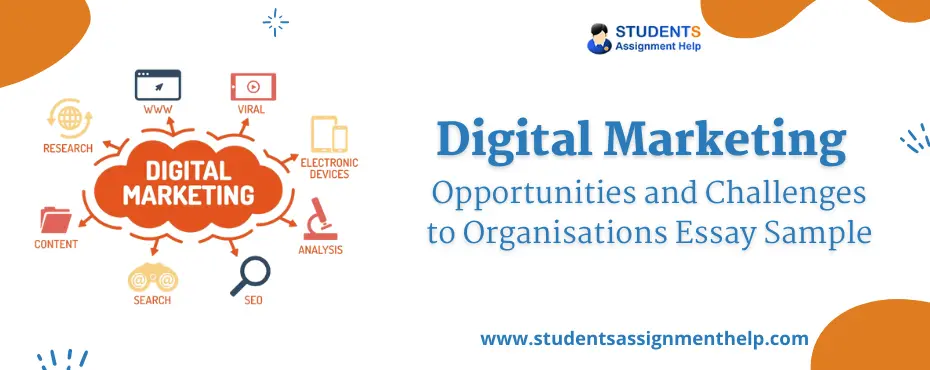Digital Marketing – Opportunities and Challenges to Organisations Essay Sample

Introduction
Digital marketing refers to the use of the latest technology for the purpose of advertising the products of the organizations (Mayar and Ramsey 2011). The introduction of the latest technology has been very helpful for organizations. Along with this, there are some challenges, which businesses have to face as a result of using this new technology. The use of digital marketing makes the use of the Internet which, acts as a medium of communication ad promotes the products of the organizations. Flexible Rates Compatible With Everyone’s Budget
There are services offered by Internet like email, IM, voice broadcast, which are used by the companies to advertise their products (Domingue and Traverso 2009). Since, the companies have to make a switch from the traditional methods to the modern technology they have to face both opportunities and challenges. The main intention of the discussion is to explain the opportunities and challenges, which organisations have to face when using digital marketing.
The major opportunities and challenges that have to be faced have been highlighted with the help of views of varied authors, which has been collected with the help of articles and journals. As highlighted by Wang (2003), in the era of globalisation, the companies have been able to improve their trade prospects, as there are no more trade barriers existing. The companies have started adopting E-Commerce in their regular working patterns in order to remain competitive in the market and have a competitive edge. Though, there has been existence of digital marketing from very old times but the rate of adoption has increased rapidly.
Hire a Professional Essay & Assignment Writer for completing your Academic Assessments
This change has been very helpful in making digital marketing a commercial medium for advertisements and promotions. The use of digital market enables the businesses to enter into a truly global and electronically operated market place. Thus, the introduction of digital marketing has been very helpful for the companies, as it has opening new doors of opportunities (Wang 2003).
Wind and Rangaswamy (2001) explained that the use of Internet has enabled the further development of the customization to customerisation. In this strategy, the use of Internet is done in order to enable customerisation at large scale. This has only been possible with the help of digital marketing which aims at devising new strategies, which will make use of latest technology for the purpose of advertisement of a organisation’s products (Wind and Rangaswamy 2001). Along with these opportunities, the companies also have to face some challenges as a result of which, the companies do not rely completely on these techniques.
According to Quelch and Klein (1996) the most common challenges, which the companies have to face are identifying the business channel, which fits the requirements of the business, the capability of digital marketing to spoil the brand image of the organisations (e.g. dell), uncertainty about its effectiveness, low entry barriers, etc. (Quelch and Klein 1996) The above discussed are few major opportunities and threats, which are to be faced by the organisations who wish to adopt the digital marketing in their routine functioning.
Along with this, it is highly important that the organisations who wish to adopt the digital marketing tools in their routine working to do proper planning regarding the implementation in the strategy. The basic thing which an organisations needs to ascertain is related to the critical evaluation of the opportunities and threats.
The above discussion, which relates to the benefits and challenges of digital marketing, needs to be taken into consideration by the organisations (Alavi and Leidner 1999). If there are more opportunities in comparison to challenges only in that situation the organisations should adopt the latest technology otherwise not. Along with this, the planning element should also include the SWOT analysis of the new strategy:
Strength:
|
Weaknesses:
|
Opportunities:
|
Threats:
|
On the basis of SWOT analysis the organisations can provide a strong base to its planning in concern to implementation of digital marketing. Further, when dealing in the context of implementation the organisations need to very careful since, it is very important and vital decision (Leverick, et al. 1998). The most important factor, which organisations need to handle, is to overcome the internal barriers, which affect the successful adoption of the proposed digital marketing strategy. The companies before implementing should get the response of the employees towards the adoption of the new strategy since, the employees are important for its execution. The organisations should undertake online promotions to spread awareness about it using the digital mediums.
Buy high-quality essays & assignment writing as per particular university, high school or college by UK, USA & Australian Writers
Along with this, before implementation the organisations should provide technological knowledge and skills to its employees to make the adoption successful. The organisations should also make the declaration of going digital to its existing customers so that they make the use of the medium. The organisations should also provide high level of security to its customers, which help in generation of interest (Baldauf and Stair 2010). It is very important for the organisations to maintain good relationship with its customers as they are the king of the market. It becomes an important element of the company’s strategy towards CRM (Ryals and Knox 2001). Thus, the company should be careful about these elements before undertaking the implementation of the designed strategy.
Along with this the organisations that have used the digital marketing have been able to gain success and stand ahead off their competitors. This explains that the strategy is very effective but should be properly planned and implemented in organisations in order to increase the benefits received from it. Thus, in the above discussed manner the organisations can engage into effective planning and implementation of the new strategy.
There are many companies, which are making the use of digital marketing techniques in order to gain a competitive position in the market. Different companies have different strategies, which they adopt in order to make their products and service popular among the customers. The companies aim at making the use of innovative services in order to lure the customers to use their products. In this essay, there are two companies whose strategies have been discussed and also there is discussion about comparing and contrasting the strategies adopted by the companies (Roberts 2012). In order to understand the Internet strategies to two competitor organizations have been used that is Amazon and Borders Group.
Talking about the organisations Borders Group, in the year 1994 it was one of largest book retailers. The Borders Group of organisations took up the Internet and related strategies in the year 2001. Before that the organisations, was making the use of the traditional methods for the purpose of publicizing its products. As the organisations were unaware about operating on Internet it made a biggest mistake to outsource this service to its competitor that is Amazon (Roberts 2012).
For the organisations, the Internet was only a medium used to take orders and augment transactions with the use of Internet. Although, later the organisations ended its strategic alliance with its competitors it was never able to gain success in the market. On the other hand, the competitor of the organisations that is Amazon was well verse with the use of Internet related actions and performed them in effective manner. The organisations were able to use it as a competitive weapon with the help of which it was able to create a strategic differentiation in its products and quality of services.
In the context of comparing the manner in which, both the companies have adopted the digital marketing it is clear that Amazon was able to make an effective use of the medium of Internet. It has become a major source of increasing its popularity among the customer group. The organisations have been able to establish a separate level for its products (Roberts 2012). The customers have been able to align well with the steps taken by the organisations, which help in maximising its profits.
From the aspect of comparing the strategies it is clear that Amazon was able to make an effective use of the digital marketing. Borders group was not compatible with the use of Internet and digital mediums and as result could these means could not make high level of positive contribution towards the organisations. In order to have an impact on the organisations it is very important that it is well aware about its use and consequences.
Stuck with a lot of homework assignments and feeling stressed ?
Take professional academic assistance & Get 100% Plagiarism free papers
Moving on to the summary of the essay it can be concluded that the use of digital marketing is very helpful for the companies but along with these there are some challenges. If the organisations are able to handle the challenges in an effective manner there are many opportunities, which will help the organisations in gaining competitive advantage in the market. Along with this, there is a discussion about the strategies undertaken by the companies like Amazon and Borders Group.
There is comparison made between the strategies made by the two companies. As a result, it is clear that Amazon was able to make better use of these mediums by designing effective strategies. As per the views of the writer, there are ample level of opportunity available to the organisations who make the use of digital marketing but it is only possible if it able to manage the challenge of the digital mediums.
References
Alavi, M. and Leidner, D.E. 1999. Knowledge management systems: Issues, challenges, and benefits. Communications of the association for information systems 1(7), pp. 1-5.
Baldauf, K. and Stair, R. 2010. Succeeding with Technology. US: Cengage Learning.
Domingue, J. and Traverso, P. 2009. Future Internet. NY: Springer.
Leverick, F., et al. (1998) Using information technology effectively: a study of marketing installations, Journal of Marketing Management 14 (8), Pp. 927-962.
Mayar,V. and Ramsey, G. 2011. Digital Impact: The Two Secrets to Online Marketing Success. US: John Wiley & Sons.
Quelch, J. A., & Klein, L. R. 1996. The Internet and International Marketing. Sloan Management Review, Pp. 60-75.
Roberts, D. 2012. Cloud strategy: choose wisely. [Online]. Available at: http://gigaom.com/cloud/cloud-strategy-choose-wisely/.[Accessed on 30 August, 2012].
Ryals, L. and Knox, S. 2001. Cross-functional issues in the Implementation of relationship marketing through customer relationship Management (CRM) European Management Journal 19(5), pp.534-422.
Wang, M. 2003. Assessment of E-service quality via E-satisfctaion in E-comerce globalisation. Electronic Journal of Information Systems in Developing Countries 11(10), Pp. 1-4.
Wind,J. and Rangaswamy, A. 2001. Customerization: the nextrevolution in mass customization. Journal of interactive marketing 15, Pp. 13-18.

